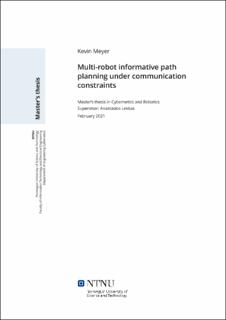| dc.contributor.advisor | Lekkas, Anastasios | |
| dc.contributor.author | Meyer, Kevin | |
| dc.date.accessioned | 2021-09-23T18:26:18Z | |
| dc.date.available | 2021-09-23T18:26:18Z | |
| dc.date.issued | 2021 | |
| dc.identifier | no.ntnu:inspera:66462738:20889613 | |
| dc.identifier.uri | https://hdl.handle.net/11250/2781027 | |
| dc.description.abstract | Samarbeidende multirobotsystemer utnyttes i større grad fordi de kan utvide mulighetene til et robotsystem utover evnene som hver enkelt robot innehar. Dette er spesielt tydelig når det gjelder heterogene robotlag, der stryken til individuelle robotplattformer kan kombineres for å dempe svakhetene hos de enkelte robotene. Denne oppgaven presenterer et system som koordinerer et lag med sensorutstyrte «quadrotor» ubemannede luftfartøy (UAVs) som skal fungere som mobile sensorer for et ubemannet bakkekjøretøy (UGV). Robotlaget opererer i et ukjent, stillestående miljø som er fylt med hindringer. Kommunikasjons-relaterte begrensninger mellom UGV og de enkelte UAV-ene pålegges systemet for å sikre tilstrekkelig gjennomstrømning av sensordata fra UAV-ene. Flere algoritmer presenteres for å muliggjøre samarbeidende og kommunikasjonsbegrenset planlegging. En algoritme presenteres som kombinerer resultatene fra individuelle utsiktsbaserte planleggingsalgoritmer. To typer formasjonsbaserte algoritmer presenteres: en som baserer seg på et forhåndsdefinert sett med formasjoner og en om kontinuerlig endrer formasjonen gjennom prøvetaking. Elementer av disse planleggingsalgoritmene blir også slått sammen for å skape to typer kombinerte planleggere. Systemene er implementert innenfor ROS-rammeverket (Robot Operating System) og testet i Gazebo-simuleringsmiljøet. Resultater fra testing av planleggingssystemene i simulerte scenarier viser at hver planleggingsalgoritme har unike styrker og svakheter. Mens den algoritmen som kombinerer individuelle planleggingsalgoritmer utmerker seg i total informasjonsgevinst, observeres det at de formasjonsbaserte algoritmene er mer robuste og effektive i å samle informasjon. | |
| dc.description.abstract | Collaborative multi-robot systems show great promise in extending the capabilities of a robotic system beyond the abilities of any single robot. This is particularly evident in the case of heterogeneous robot teams, where the strengths of individual robotic platforms are combined to mitigate their corresponding weaknesses. This thesis presents a system that coordinates a team of sensor-equipped quadrotor Unmanned Aerial Vehicles (UAVs) acting as mobile range sensors for an Unmanned Ground Vehicle (UGV). The robot team operates in an unmapped, static environment populated by obstacles. Communication constraints between the UGV and the individual UAVs are imposed to ensure an adequate throughput of sensor data from the UAVs. Several path planning algorithms are presented which enable collaborative and communication constrained planning. A collaborative exploration planner is presented which combines the results from individual view-based exploration planners. Two variants of formation-based planners are also presented; one uses a set of predefined formation poses and while the other continuously reshapes the formation through sampling. Elements of the aforementioned planners are also merged to create two types of combined planners. The systems are implemented within the Robot OperatingSystem (ROS) framework and tested in the Gazebo simulation environment. Results from testing the planning systems in simulated scenarios show that each planning algorithm has unique strengths and weaknesses. While the collaborative exploration planner excels in total information gain, the formation-based planners are observed to be more robust and efficient in gathering information. | |
| dc.language | eng | |
| dc.publisher | NTNU | |
| dc.title | Multi-robot informative path planning under communication constraints | |
| dc.type | Master thesis | |
